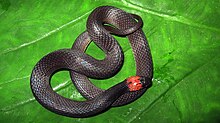
Epicrates is a genus of non-venomous snakes in the subfamily Boinae of the family Boidae. The genus is native to South America and Central America. Five species are currently recognized as being valid, including the rainbow boa.

Garter snake is the common name for small to medium-sized snakes belonging to the genus Thamnophis in the family Colubridae. Native to North and Central America, species in the genus Thamnophis can be found in all of the lower 48 United States, and nearly all of the Canadian provinces south of the Northwest Territories and Nunavut—with the exception of Newfoundland and Labrador. They are found from the subarctic plains of west-central Canada east through Ontario and Quebec; from the Maritime Provinces and south to Florida, across the southern and central U.S. into the arid regions of the southwest and Mexico, Guatemala and south to the neotropics and Costa Rica.

The Anomalepididae are a family of nonvenomous snakes, native to Central and South America. They are similar to Typhlopidae, except that some species possess a single tooth in the lower jaw. Currently, four genera and 15 species are recognized. Common names include primitive blind snake and dawn blind snake.

The Leptotyphlopidae are a family of snakes found in North America, South America, Africa and Asia. All are fossorial and adapted to burrowing, feeding on ants and termites. Two subfamilies are recognized.
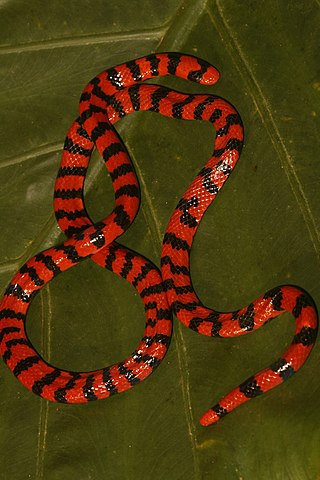
The Aniliidae are a monotypic family created for the monotypic genus Anilius that contains the single species Anilius scytale. Common names include the American pipe snake and false coral snake. It is found in South America. This snake possesses a vestigial pelvic girdle that is visible as a pair of cloacal spurs. It is ovoviviparous. It is non-venomous, and its diet consists mainly of amphibians and other reptiles. Two subspecies are recognized, including the nominate subspecies described here.

Clelia is a genus of snakes, one of three genera with species with the common name mussurana or musurana It is a genus of large snakes in the family Colubridae. The genus is endemic to Central America and South America, and species of Clelia are found from southern Mexico to Brazil. They specialize in ophiophagy, i.e., they attack and eat other snakes. Currently seven species are recognized as being valid. They have other popular names in various countries, such as zopilota in Central America and cribo on some Caribbean islands.
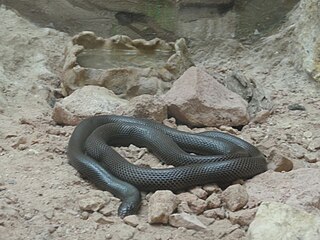
Atractaspis is a genus of venomous snakes in the family Atractaspidae, also known as the stiletto snakes. The genus is endemic to Africa and the Middle East. The genus contains 15 species that are recognized by ITIS. Others recognize as many as 21 species. 23 are listed here.

Ninia atrata, known commonly as Hallowell's coffee snake, Hallowell's earth snake, the red-nape snake, and the South American coffee snake, is a species of small terrestrial snake in the family Colubridae. The species is native to southern Central America and northern South America.

Opheodrys is a genus of small to medium-sized nonvenomous colubrid snakes commonly referred to as green snakes. In North America the genus consists of two distinct species. As their common names imply, the rough green snake has keeled dorsal scales, whereas the smooth green snake has smooth dorsal scales.

Tropidoclonion is a genus of snake in the subfamily Natricinae of the family Colubridae. The genus is monotypic, containing the sole species Tropidoclonion lineatum, commonly known as the lined snake. The species is endemic to North America.

Nerodia is a genus of nonvenomous colubrid snakes commonly referred to as water snakes due to their aquatic behavior. The genus includes nine species, all native to North America. Five of the species have recognized subspecies.

Leptodeira is a genus of colubrid snakes commonly referred to as cat-eyed snakes. The genus consists of 18 species that are native to primarily Mexico and Central America, but range as far north as the Rio Grande Valley region of Texas in United States and as far south as Argentina in South America.
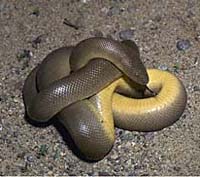
Charina is a genus of nonvenomous boas, commonly known as rubber boas, found in North America. Two species are currently recognized.
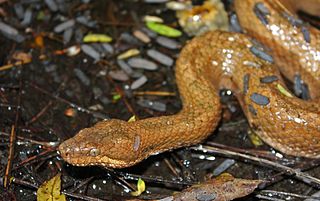
Tropidophis, common name Caribbean dwarf boas, wood snakes or West Indian wood snakes, is a genus of dwarf boas endemic to the West Indies and South America. Currently, either 17 or 33 species are recognized, depending on the authority.

Tachymenis is a genus of venomous snakes belonging to the family Colubridae. Species in the genus Tachymenis are commonly known as slender snakes or short-tailed snakes and are primarily found in southern South America. Tachymenis are rear-fanged (opisthoglyphous) and are capable of producing a medically significant bite, with at least one species, T. peruviana, responsible for human fatalities.

Ninia sebae, commonly known as the redback coffee snake or the red coffee snake, is a species of small terrestrial snake in the family Colubridae. The species is native to southeastern Mexico and Central America south to Costa Rica. Although it resembles some venomous coral snakes in color and size, it is not venomous and seldom bites humans.

Oxyrhopus, the false coral snakes, is a genus of colubrid snakes that belong to the subfamily Dipsadinae. The genus is found in Central America and the northern part of South America, and it includes 15 distinct species.

Imantodes is a genus of colubrid snakes commonly referred to as blunt-headed vine snakes or blunt-headed tree snakes. The genus consists of seven species that are native to Mexico, Central America, and the northern part of South America.

Urotheca is a genus of snakes of the family Colubridae. The genus is endemic to the New World.
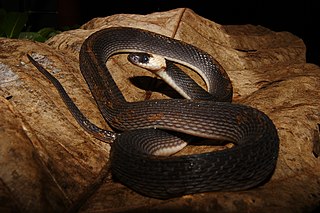
Ninia hudsoni, also known commonly as the Guyana coffee snake and Hudson's coffee snake, is a species of snake in the family Colubridae. The species is native to northwestern South America.
